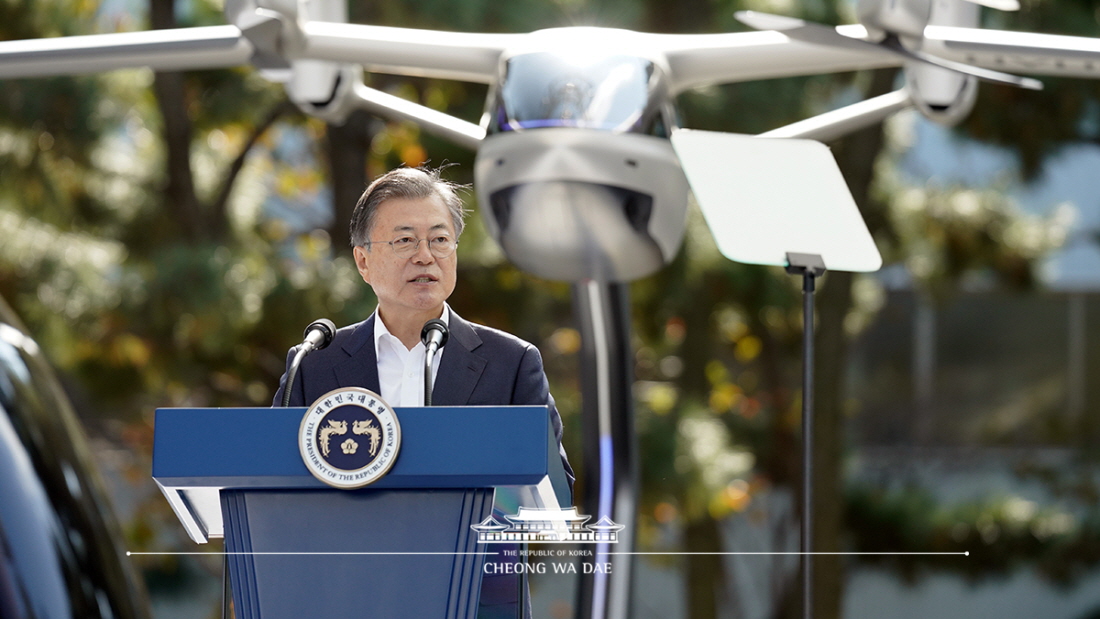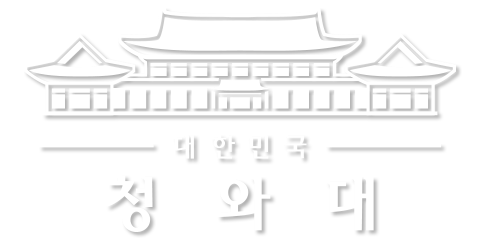이 웹사이트는 제19대 대통령 임기 종료에 따라 대통령기록관이 「대통령기록물 관리에 관한 법률」에 의해 이관받아 서비스하는 대통령기록물입니다. 자료의 열람만 가능하며 수정 · 추가 · 삭제는 불가능합니다.
다만, 「개인정보보호법」에 의하여 개인의 정보를 보호받기 원하시는 분은 관련 내용(요청자, 요청내용, 연락처, 글위치)을 대통령 웹기록물 담당자(044-211-2253)에게 요청해 주시면 신속히 검토하여 조치해 드리겠습니다. 감사합니다.
SPEECHES & REMARKS
BRIEFINGS
Remarks by President Moon Jae-in During Visit to Eco-friendly Future Car Manufacturing Plant in Ulsan

Fellow Koreans, citizens of Ulsan,
Ulsan is the heart of Korea’s automobile industry. The city is the world’s largest automobile manufacturing factory, producing 6,000 cars daily – 1.5 million cars annually – in cooperation with some 500 businesses employing over 50,000 workers. Korea’s first domestic model, the Pony, was born here, and the Nexo – the hydrogen-powered vehicle, also known as a running air purifier – that I ride in was also made in this city.
Ulsan is always dashing toward its goal of producing the world’s best. Korea has become an automobile manufacturing powerhouse, ranking 7th in the world last year and 4th this year. We are running at the forefront when it comes to future cars. In particular, today is the day when we broke the 10,000 mark in sales of hydrogen vehicles for the first time in the world, while having surpassed the milestone of 10,000 commercial electric vehicle sales as well. With us today are the buyers of the 10,000th hydrogen and commercial electric vehicles. I congratulate Hyundai Motor Company and the purchasers on their writing a new chapter in history.
When global automobile manufacturers concentrated on developing electric vehicles, Hyundai made bold investments to develop hydrogen cars in addition to electric ones. As a result, the company produced the world’s first mass-market hydrogen vehicles and now ranks first by far in sales. Hyundai’s Ulsan plant is the greatest business innovator, and it is also the No.1 business in terms of labor-management cooperation, future vision and efforts to overcome the COVID-19 crisis. From the early stages of the COVID-19 outbreak, Hyundai’s labor and management set out to engage in not only in-house disease prevention activities but also community outreach with its partner vendors.
When a confirmed COVID-19 case was reported among its employees, the company took the bold action of suspending operations at its plant and had the site thoroughly decontaminated to stem the spread of the virus. It has designated a weekly epidemic prevention and control day on which it carries out disinfection. In addition, its employees have been given a longer lunch break, thereby making social distancing easier to practice. Last September, the company’s labor and management adopted a social declaration for mutual growth and change in industrial relations, in order to jointly respond to upcoming changes in the future automobile industry and secure employment and mutual gain with parts suppliers.
Today, I am very pleased to be able to present Korea’s strategy for the era of future cars here at this site of innovation and mutually beneficial partnership. Our people may find hope for our economy in the promise of future cars.
Ulsan has become the city that represents Korea’s future cars and hydrogen ecosystem. It is taking the lead in building more hydrogen stations and promoting hydrogen cars. As the special hydrogen regulation-free zone, the city is helping businesses to innovate. Scientists at Ulsan National Institute of Science and Technology are joining in the development of such new products as flying cars, filling us with greater expectations. I offer encouragement to universities, research institutes and Hyundai Motor Company’s labor and management as well as its suppliers, who are carving out a bright tomorrow with future cars. I am grateful to the citizens of Ulsan as well as Mayor Song Chul-ho and relevant Ulsan Metropolitan Government officials.
Fellow Koreans,
Future cars are becoming a game changer for the auto industry. The electric car manufacturer Tesla ranks first in market capitalization, overtaking other global automakers. The rechargeable batteries, artificial intelligence and semiconductors that determine future cars’ performance and quality are rapidly growing industries. Future vehicles involve broad upstream and downstream industries, including electronics, chemistry, optics, machinery and energy. Compared to cars running on internal combustion engines, future automobiles use fewer components, thereby lowering the entry barriers for auto production. The parts linked to autonomous driving and other new areas also present growth opportunities for small to mid-sized business ventures. Hydrogen-fueled vehicles have boundless potential to spearhead progress in related industries such as hydrogen-powered drones, trains, ships and construction equipment.
In early 2018, I took a ride in a domestically-built, autonomous hydrogen-fueled vehicle. Its pilot run had been carried out on an expressway without the help of a driver. When I visited France on a state visit in October the same year, I saw a hydrogen station in the center of Paris and hydrogen-powered taxis operating there that had been imported from Korea. I arrived at today’s venue in my hydrogen-powered Nexo. I always support our future cars.
Having formulated a hydrogen economy roadmap and a vision and strategy for future cars, the Government is now making big strides toward the goal of ensuring that Korea ranks 1st in terms of future car competitiveness by 2030. Compared to 2017, supplies of hydrogen-fueled and electric cars have increased 74 and eight times, respectively, to 10,000 and 124,000 today. Both types of cars have also seen exports increase by four and seven times, respectively. These achievements are all the more impressive for having come amid the COVID-19 crisis. Korea also boasts the largest global market share for the rechargeable batteries that can determine how well an eco-friendly vehicle performs.
For the era of autonomous driving, we are also making steady legal and institutional preparations. We have – for the first time in the world – devised safety standards for autonomous driving on expressways and streamlined procedures to issue temporary driving permits for Level 4 fully autonomous vehicles. We have also overhauled the insurance system for self-driving cars. By allowing certain exceptions to relevant regulations, we are conducting demonstration tests on unmanned shuttles and other autonomous transportation services in Sejong City, Daegu and Pangyo.
Fellow Koreans,
The global auto market will be rapidly realigned around future cars. We are already seeing intensified competition concerning electric vehicles, and Tesla is bringing eco-friendly, autonomously driven vehicles to the market. Only when we too respond boldly and swiftly can we keep our status as an automobile powerhouse and emerge as a country spearheading the Fourth Industrial Revolution. In addition to developing groundbreaking car performance that will surpass the U.S. and European brands and China’s price competitiveness, we need to develop advanced technologies to commercialize self-driving cars.
The Government has selected “eco-friendly future mobility” as one of ten Korean New Deal projects. By 2025, we are planning to invest more than 20 trillion won in green mobility such as electric and hydrogen-fueled cars. We will improve road systems and the industrial ecosystem across the board and proceed with three key measures.
First, we will speed up the dissemination of future cars. We will make 2022 the first year that future cars are widely used among the public and supply 1.13 million electric vehicles and 200,000 hydrogen-fueled cars by 2025. In addition, we will commercialize Level 4 autonomous vehicles for the first time in the world in 2027.
To make charging for vehicles as frequently available and convenient as that for mobile phones, EV charging stations will be built in various locations by 2025 – 500,000 chargers for residential hubs, including apartment complexes and stand-alone houses, and 15,000 chargers along transportation routes such as in expressway rest areas. One hundred hydrogen stations will be built by the first half of next year – mainly in the Seoul metropolitan area – and a total of 450 stations will be built by 2025. We have devised additional measures such as how to utilize idle public lands and make charging stations economically viable. Without the charging infrastructure, we cannot accommodate an increasing number of future cars. We will fully mobilize the capabilities of all related ministries and agencies to complete their construction in time.
Beginning next year, new vehicle purchases by public institutions will be limited to electric or hydrogen-powered automobiles, and heads of public organizations must switch out their vehicles if not already using one of those choices. A new system will set eco-friendly vehicle purchase targets for taxi and bus companies and other large-scale buyers. We will secure price competitiveness for eco-friendly cars by offering subsidies and tax incentives and by lowering energy cost burdens. Subsidies to operators of commercial vehicles like trucks and buses will be increased as their switch can have a greater positive impact on the environment.
Second, the Government will nurture future cars and related industries as main export sectors and help expand relevant jobs. The automobile industry is the backbone of economic growth and employment, accounting for 12 percent of manufacturing exports and 470,000 jobs. We will help export 460,000 electric vehicles and 70,000 hydrogen-powered automobiles by 2025 and expand exports of parts, materials and other items made by related industries, thereby increasing the number of jobs. To this end, we will help expand the distance electric vehicles can travel by 50 percent and their electricity efficiency by 10 percent by 2025. We will expedite the advance of domestic hydrogen-powered vehicles into markets in North America, Europe and China by improving their durability and fuel efficiency.
The Government will help foster Korea’s secondary battery and fuel cell industries, which rank first in the world, to make their roles comparable to that played by the country’s semiconductor industry. We will help rechargeable battery related parts, materials and equipment grow into a new industry with annual sales of 13 trillion won. In addition to developing core parts related to self-driving, such as automotive semiconductors and sensors, we will help nurture hydrogen-powered drones, trains, ships and construction equipment into new exports.
Third, we will accelerate the transition to an industrial ecosystem centered on future cars. Self-driving technology will be broadly utilized to address social issues related to autonomous delivery, self-driving cars and healthcare. We will establish quality data dams linked to autonomous driving and build related infrastructure as planned, including the preparation of safety guidelines for fully autonomous vehicles. By doing so, we will actively help SMEs and middle-market companies develop and commercialize their technology.
The Government will establish a business reorganization support office to help one thousand automotive parts companies transition to future car-related lines by 2030. We will push ahead with various support such as R&D exclusively for business reorganization. We will invest more than 350-billion-won worth of funds in business ventures and startups to assist the growth of the future car industry.
To prepare for the future car era, we will put a repair service system in place and nurture 2,000 talented ground workers. We will also push ahead with making the entire cycle from manufacturing to scrapping eco-friendly.
Fellow Koreans and Ulsan citizens,
The next five years are critical. Amid fierce global competition, these five years will be the golden time for us to play a leading role in the future car market. We are already at the forefront in many areas. The safety and excellence of Korea-made hydrogen-powered and electric vehicles are globally recognized.
We have – in just a half century – leapt forward to become an auto manufacturing powerhouse, and we possess technology as well as the passion and potential to lead the world in this field. The day when we will emerge as an unmatched future car powerhouse is not far away. We will join forces with the people and usher in the new era of future cars by all means.
Thank you.



